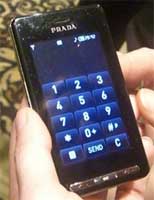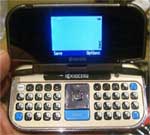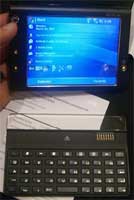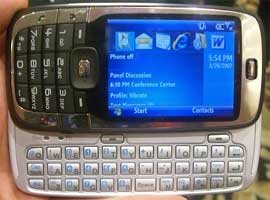Pepcom's got a thing for martini bars made from single blocks of carved ice. They had one at CES and wouldn't you know it, they had one at Monday night's March Madness Mobile Focus party, where media got a chance to preview the latest handsets and other goodies from manufacturers while, well, eating and drinking too much. Beyond hitting three shots in a row to win a prize and drinking a few March Madness Martinis, here's what I saw:
 |
 |
 |
Sony Ericsson was showing off two new handsets actually designed for the US market. The w580 Walkman phone is a nicely thin (14mm) slider featuring SE's Walkman player 2.0, a 2" QVGA display, 2mp camera, quad-band GSM/EDGE connectivity, and stereo Bluetooth. The z750 clamshell features a shiny finish with "hidden" external OLED display and a 2.2" internal QVGA display, 2mp camera, and tri-band HSPDA access. Both phones will be available later this year. I also got a chance to paw SE's w880i Walkman phone (a GSM model not destined for the US) and man if it's not a million times better in person than in photos. The w880 is super thin and has a very nice brushed metal front finish that made me want it, even if it doesn't really do that much more than the older and thicker w800i I had in my own pocket.

LG had some new Verizon and Sprint-bound models on display, but I spent my time at their booth holding the precious Prada phone in my hands. This "iPod killer" touchscreen smart phone is oddly beautiful and boring all at the same time: it's basically a slab of metal and glass that doesn't do much until you make contact with the touch screen, and then it does what a touchscreen phone does, magically morphing itself into a dialing keypad here, an SMS composition window there, and so on. While Prada is not destined for our shores, LG would go so far as to tell me that "the technology will be making it to the US" in some form. Soon...or sorta soon, anyway.

Nokia showed me their 6110 Navigator GPS phone, which was unveiled at 3GSM in Barcelona. The slider handset combines GPS navigation and location-based services with a quad-band GSM/EDGE phone with HSDPA capabilities, and also features a 2mp camera, QVGA display, and a microSD card slot supporting 2GB cards. Nokia also had their N-Series range on display and confirmed that that N95 is, at long last, about to start shipping. I then ogled the N76 a few times just to remember falling in lust with it at CES in January. It's a thin flip phone that runs Series 60 and features that all important "fifty cent part," the 3.5mm headphone jack.

Kyocera had a slew of US-bound handsets on their table, including the CDMA M1000, a candybar phone that opens "the long way" to reveal a full QWERTY board on the inside, a la LG's enV for Verizon. The M1000, along with a curvy, chrome clamshell dubbed E5000, features a 1.3mp camera and EV-DO support, and will ship later this year.

HP showed off their 500 series IPAQ Voice Messenger, a WiFI-enabled GSM/EDGE smartphone that can do VoIP calls. Aimed at the enterprise user, the Voice Messenger will ship with Windows Mobile 6 and features a slew of user-customizable controls including shortcuts that can be programmed to speed dial numbers, access URLs on the Web, and perform a variety of other tasks.

Motorola had the super slim, curved Z8 slider on display. It's thin, and it's curved - the latter feature designed to better contour to the user's face during calls. Moto was also showing the q9h smartphone I wrote about earlier today. I'm hoping to get some more quality time with both phones in the next few days.
Speaking of smartphones, iMate has dropped the "Jaq" naming scheme and rechristened their line "Ultimate." They were showing off the Ultimates - a group of phones all packing the same high-end smartphone specs into a plethora of form factors.
 |
 |
And smartphone fave HTC had a crowd gathered 'round its table to peep the Advantage, Vox, and Shift. The Advantage toes the line between smartphone and ultramobile PC (UMPC) by combining a quad-band EDGE radio with tri-band HSDPA, and WiFi and Bluetooth connectivity with a 5-inch VGA touchscreen, 3mp camera, 8 GB hard drive, 256 MB or RAM, and a 624 MHz Marvell processor with ATI graphics. The Advantage also features a snap-on magnetized keyboard so the handset can be used as a traditional (if quite large) candybar phone or as a laptop-esque PDA. HTC will be selling the Advantage direct in the US under their own name beginning in June.
The Shift goes Advantage a step further into full-blown laptop mode, running Windows Vista Business Edition on a 7" touchscreen backed by a 30GB hard drive and 1GB or RAM. Shift features tri-band HSDPA and EDGE for cellular connectivity along with 802.11g for wireless broadband.
Last but not least at HTC's both was the Vox, a more traditional smartphone featuring a candybar design with slide-out QWERTY board. The Vox is smaller than other HTC QWERTY phones like the Cingular 8125/8525, but it sacrifices screen size in order to fit into that neat little package.
All that and CTIA hasn't even officially begun ... on to the show floor!